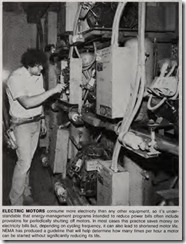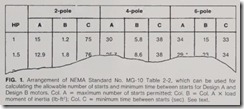Cycling of motors for energy conservation
Revised NEMA Standards Publication No. MG-10 provides a guideline for the maximum permitted starts per hour and minimum off time between starts.
NCREASED COST of electricity since the 1978 energy crisis has popularized the practice of cycling on and off items such as HV AC and refrigeration equipment motors. The energy savings gained by doing so must be balanced against the possihle shortening of the life of the motor and its starting equip ment. Until now there has been no generally accepted method for deter mining how many times per hour a motor can be started without signifi cantly reducing its useful operating life. The only available guideline has been NEMA’s Standard MG-1, Clause
12.50. It limited the number of starts to two from ambient or one start from rated-load operating temperature.
However, this information is not appli cable to repetitive start-run-stop-rest cycles used in energy-manage ment pro grams. The new information contained in NEMA MG-10 Energy Manage ment Guide For Selection And Use Of Polyphase Motors is intended specifi cally to provide the information needed to make these calculations for NEMA Design A and Design B motors.
Causes of cycling damage
Effective service life of motors is often determined not by the total num ber of hours that it has run, but by the number of starts it has been subjected to. There are two components that singly or in combination can cause a motor to fail due to cycling. The first is overtemperature, and the second is the high electromagnetic stresses impoS’ed during the starting period.
The insulations _of motor windings are particularly temperature-sensitive. A rule-of-thumb says that the life of the insulation is halved for each 8°- 12oC increas€ of operating temperature above its rating. Because electric heat ing effect increases as the square of the current, the average six-times-normal FLA experienced during starting quickly raises temperatures within a motor. When a motor is started, the rate of the temperature rise in the stator and rotor winding is very high There is little heat transfer from the winding to the surrounding core. Addi tionally, shaft-driven ventilating fans are relatively ineffective until the motor is running at rated speed. As a result, several starts in succession will cause the temperature to exceed th e thermal limit of the stator or rotor winding.
Insulation breakdown as a function of temperature is a chemical proce ss that is accelerated by increased tem peratures. However, heat has several other consequences. Th e resistance of the insulation d ecreases as tempera ture rises. Thus the windings are more prone t shorting. Also , th e rotors of motors can be damaged . Becau se th e rotor winding is part of the heat sink, its bars can melt or soften and be distorted by centrifugal and electro magnetic forces. Large motors drivi ng equipment that requires a long tim e to accelerate to operating speed are more likely to experience rotor damage, but smaller motors are also vulnerabl e to this type of thermall y induced dam age.
Starting current also exerts strong repelling forces on stator-winding end coils. Even slight movement of th e coils can, over a period of tim e, cause insulation failure or embrittl emen t of the
coils themselves . Thi s is further com plicated by th e fact th at some insu la tions soften with elevated temper ature and increase the ability of coils to move in response to the forces. Vibration ,
especially during long starting peri ods, adds to the possibilit y of coil mech anical failure.
How driven loads affect motors
Heating effect depend s upon th e amount of current required to star t a motor. The longer it takes to accelerate a load up to operating speed, the more total heat will be released. Total start ing time depends chi efly on the n ature of the load that mu st he brough t u p to speed. The time to reach operating speed can be calculated f rom
t = Wk 2 X (rpm /307.5) X T.
wher e Wk2 is the inertia of the motor plu s th e driven equipment and T. is the torqu e available for overcoming inertia (motor torqu e minu s requi red load torque).
Moment of inerti a (Wk2 ) is of tenref erred to as th e flyw heel eff ect and i the produ ct of th e weight of the ohj ect times its radiu s of gyration squared. The unit s are in lh-ft2 . A centr if ugal pump starting with its d i scharge valve closed typically is a load th at can be brought to speed quickly. Bu t large fans are usuall y high -inertia items whose starting time m ay be aroun d 20 sec. Cold air imposes a heavier load than does warm air. Thus, fans that are par t of H VAC systems are particu larly th e type of loads th at must be cycled wi th care.
Besides h eating due to the length of ti m e it takes to reach operating speed, m otors m u st be able to absorb and dissipate th e energy required to rotate th e load. Motors are energy-conversion devices. They consume electrical ener gy; h eat is the result. The energy to be absorbed durin g an acceleration from rest to f ull speed with zero load torque is equal to th e kinetic energy of the rotating m ass at full speed and is inde penden t of starting time. So there are many factors that enter into the deter mina tio n of permissib le starts per hour.
NEMA calculation
Fig. 1 shows h ow Table 2-2 in N EMA’s M G-10 is arranged . Depending upon the number of motor poles (a3600-rpm 60-Hz motor has 2; 1800 has 4; 1200 h as 6), th ere is given an A, B, and C value for each h p size. The A and B values do not have any relation to wheth er the motor is NE M A Design A or Design B. The A va lue ind icates the recomme nded maximum number of starts based chiefly on the requirement to minimize the effect of wind ing stress imposed by repeated starts. Value B is th e number of permitted starts (A) m ul tiplied by a value of Wk2 that ind u stry-wide experience has shown a standard squirrel-cage induction motor of that hp can accelerate without caus ing inju rious temperature rise. Stan dard cond itions of voltage, frequency, tem perature rise, etc. were used in de- rivi ng these values of Wk2• Because the loads to which motors are actually applied tend to vary f rom the recom me n ded Wk2 limits (fan loads generally far exceed them), the value B must be divided by the actual value of Wk2 for the load of the motor being analyzed. The lesser of the two numbers-either the A value or the calculated result of B/Wk 2 -represents the maximum number of times per hour that the motor can be started.
Having found the permitted number of starts does not mean that the motor can be started that many times in rapid succession. There must be a min imum waiting time between each start to allow the motor to cool sufficiently before the next start. This minimum rest time, in seconds, is given by the value in the appropriate C column.
As an example of using the table, assume that a Design B motor is rated at 1 hp, 1800 rpm, and is directly con nected to a pump having a Wk2 of 0.24 lb-ft2 From the table, A = 30 and B = 5.8; B/Wk2 = 5.8/0.24 = 24.17.
Thus the motor can be started 24 times pe r hour and must have a minimum of 38 sec (the value shown in column C for the rated hpJ between starts.
The information a ·ai1able in the NEMA standard shouk be used only as a guide. All pertinent factors must go into actual calculations. For exam ple, a belt-driven item imposes a differ ent load on the motor from one with a similar Wk2 that is directly connected. The ratio of the load and motor rpm must be factored in. Also, ambient temperature significantly affects the number of times a motor can be started without an excessive temperature buildup. The lower the temperature, the more rapidly the heat can be dissi pated. Other factors-shock loading, method of deceleration (coasting, me chanical or dynamic braking), reduced voltage starting-all have different heating effects.

